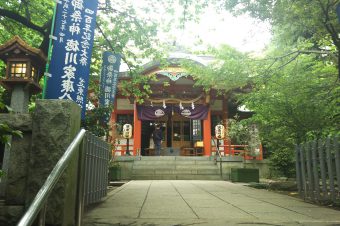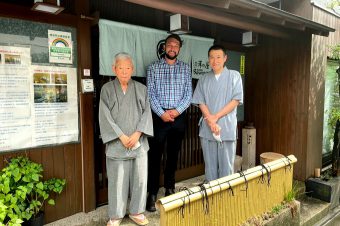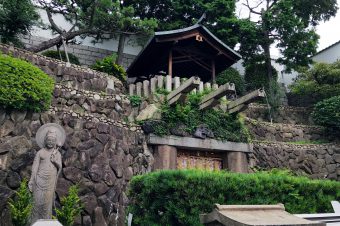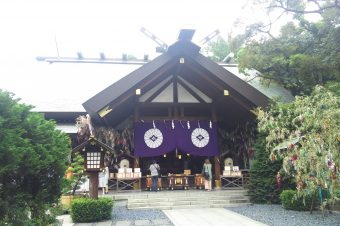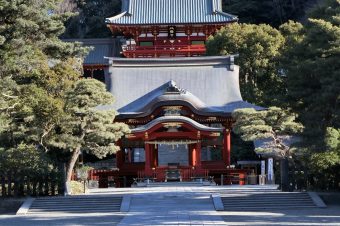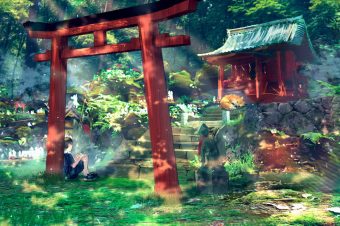In ancient times, people would make pilgrimages to different shrines and temples all over Japan. The goal of these pilgrimages was to worship the kami in their many homes, then collect the goshuin, or simply shuin, of these many shrines and temples as proof of their dedication and devout belief in the kami that inhabit them.

The goshuin are stamps unique to each shrine and temple and originated as certifications of a worshipper’s ability to copy the sutra of the shrine or temple. The stamp is combined with handwritten calligraphy that marks the date it was received and the name of the shrine and/or temple, as well as a phrase on the right hand side that can mean you worshipped at the shrine, or what the purpose of the shrine/temple, such as protecting the Emperor’s home.
In today’s world, anyone can visit a shrine and temple and purchase a goshuincho, a small stamp book available at the small store where the miko (Unmarried women serving God) and priests sell ofuda and small charms that vary from ensuring a safe childbirth to good luck in examinations, politely request a goshuin from the attendant at the small store, which usually run between 300 and 500 yen, depending on the shrine and temple.
One such course that is popular today is the Ten Jinja of Tokyo, which are located throughout the twenty-three wards of Tokyo. These shrines were part of twelve that were given special status by Emperor Meiji, who was responsible for bringing about the period known as the Meiji Restoration, as places of power that could bring about the prosperity and continued growth of the new capital. Because of their strategic locations, they were also considered to form a barrier around what was once Edo Castle and was meant to protect the Emperor and his family from evil spirits.

The shrines have been rebuilt many times, especially after the Great Earthquake of 1923 and the fire bombings that occurred during World War II, but they now stand resolute and quietly powerful among that imposing skyscrapers of the Tokyo skylines.
These ten shrines are: Kanda Myojin, Hie Jinja, Tomioka Hachiman-gu, Nezu Jinja, Kameido Tenjin, Hakusan Jinja, Shiba Daijingu, Shinagawa Jinja, Oji Jinja and Akasaka Hikawa Jinja.
Jeremiah, my fellow intern, and I, visited Hie Jinja on the second day of our arrival in Japan, and it was our first time at a Shinto shrine. We entered through the large torii and made our way up the imposing cement stairs that lead to the sando, or approach, of the shrine. We watched silently as parishioners made their way to the haiden to make their small money offerings and pray to the kami.

Mothers with their newborn children approached the haiden to present their babies and thank the kami for their health and plead them to keep them safe and healthy for the rest of their lives. Proud parents brought their young children to give thanks for them reaching the milestone ages of 3, 5, and 7 years old. It was an honest and enlightening first look at the spiritual beliefs of Japanese society.

The second shrine we visited was Akasaka Hikawa Jinja, the shrine that houses the ujigami that protects the district where our office is located.

While I’ve already written about my experience visiting Hikawa Jinja, it bears mentioning that it also well-known for providing peace and prosperity in your home, helping businesses to thrive, and finding a good match for you. As proof of these claims of providing good fortune, it is known to have survived several major disasters throughout its over 1,000-year history, including the Great Kanto Earthquake of 1923 and the Great Tokyo Air raids of World War II. It has been designated a Tokyo Metropolitan Area intangible cultural property.

We visited Nezu Jinja on a day that was the right mix of cloudy and sunny, where it was warm enough to work up a sweat, but the clouds kept the Sun from burning us to a crisp.

We made our way through the peaceful street of Yanaka and made our way through Yanaka Ginza street, a usually busy shop street, while it was still early enough that it wasn’t overrun by tourists, tried a little piece of heaven called Menchi katsu (pork croquette), and had lunch at a small café called Nekojitaya, a cat themed pasta restaurant. Once we arrived in Nezu Jinja, we were distracted by the Kami-ike, a small pond filled with koi fish and lots and lots of kame, or turtles (unfortunately, none of the ninja kind). The shrine is beautiful, and it is well-known for its plentiful azalea garden in spring. Another feature it is known for is the Senbon Torii, a tunnel of torii gates that leads to the Otome Inari shrine and is a perfect background location for pictures in traditional yukata outfits.

Kanda Myojin is located just a few blocks away from Akihabara Electric town, the Otaku Capital of Japan. I found the shrine at the end of a small street lined with wedding apparel and gift shops. Kanda Myojin is well-known for hosting the Kanda Matsuri, which is one of the three biggest matsuri in Tokyo and is held in May every odd numbered year.

It is also known for providing good luck charms for technology-based situations, such as ensuring your computer won’t stop working in the middle of writing your graduate thesis. Another interesting item I found there were little ema tablets with anime characters on them, or blank ones that you can draw your own character and prayer. Off to the left hand side of the shrine, just past the entrance, there is a statue of Ebisu-sama, one of the seven Tokai Shichifukujin, or kami of good fortune and prosperity, so make sure to stop by and pay your respects to the jolly kami before you try your luck at the prize machines in Akihabara.

I visited the Tomioka Hachimangu, a shrine with monuments dedicated to Ino Tadataka and the sport of Sumo. Ino Tadataka is known as the man who drew the first, geographically correct map of Japan after walking all its length, width, and coasts over a length of time of 17 years and walked an estimated 34,913 km by the time he passed away.

Tomioka Hachimangu is known as the starting point for his many expeditions to trace the entirety of Japan. Tomioka is also known as the birthplace of Sumo wrestling, and located there was a monument dedicated to several Sumo wrestlers of the Ozeki, or the second highest, ranking, which contains casts of their hands and feet that visitors can hold their own hands up to, just to see the difference in size. I think many people would be surprised to learn that Sumo started out as a Shinto ceremony called Kanjin-zumo, which was created in the Muromachi period in order to raise funds to build and repair shrines and temples.

On the same say as Tomioka Hachimangu, I visited the Kameido Tenjin, a lovely shrine with a hanging wisteria garden that is usually in bloom in late Mid-April to early May months and another kame-ike, such as the one we found in Nezu Jinja.

The Kameido Tenjin is what is known as a Tenman-gu shrine, a shrine that is dedicated and enshrines the spirit of Sugawara no Mechizane, a Japanese scholar who on his death was elevated to the Kami of learning. Because of this, the shrine sees many students from junior high schools, high schools, and universities visiting during their examination periods, hoping that the Kami will assist them in passing the exams.
Afterwards, I walked down the streets of Kameido Katori, which were sadly closed for the day, and found a sweets shop called Funabashiya, a shop specializing in Kuzumochi, a traditional Japanese treat made with mochi cakes (sticky rice cakes), Kuromitsu (black sugar syrup), and Kinako (roasted soybean flour). While mochi is not really my favorite Japanese treat, they had black sugar ice cream Monaka, a type of wafer sandwich cookie, that I really enjoyed.

Oji Jinja is located inside a small park, just outside the Oji JR Line station, so it’s one of the easier shrines you can visit, since most other have been a good walking distance from their closest train and bus station.

The shrine has the site of one of the oldest ginko trees in Tokyo (Tokyo designated natural monument), an estimated 600-years old, which means it has been around since the Oji Jinja was built in 1324. The shrine itself is grand and one of the most interesting things is that it had an interactive guide stand at the entrance that explained everything from proper prayer etiquette to the history of the shrine. This is interesting because it was the first time I had seen a machine like that in any of the shrines and temples I have visited, and it would be very convenient to have more of them in other shrines and temples. On a lighter note, there is also a small Inari shrine just off to the side of the main haiden that is dedicated to hair and the art of hair dressing. Everything from praying to the kami to stop hair loss to aspiring hairdressers praying for good luck in an interview.
The area around the shrine has several parks for families and museums dedicated to the local home hero, Shibusawa Eiichi, who is known as a great economist and the person in charge of introducing western capitalism into Japan during the Meiji Restoration. The park where the shrine is located also has a small river that families and their children are welcome to use to splash around and cool down on a hot summer day.

Shiba Daijingu is a quick walk from Daimon station, and a small property compared to all the others.

The property is known for their senkihako charms, clay charms in the shape of traditional Chigibako which are stacking boxes where everything for clothes to fruit were stored and are symbols of marriage with someone who can provide plenty to the household. These charms are specifically for women looking for a husband who can provide a good life for them. Now a days, though, they are meant as good luck in marriage. Shiba Daijingu is also a block away from the Zojo-ji temple, also known as the Tokugawa family temple, and the Tokyo Tower, so this makes Shiba Daijingu a good stop while visiting those two famous locations.

The last shrine on my pilgrimage was Shinagawa Jinja, another shrine said to house another of the Tokai Shichifukujin, this time Daikokuten the Kami of wealth in commerce and harvests, as well as Amenohirimeno-no-Mikoto, the god of safe sea travels and answering prayers. Shinagawa shrine is the home of the last surviving fujizuka, a substitute ‘mountain’ meant for those who are unable to make the trip to the real Mt. Fuji and is built from volcanic rock collected and transported from the foot of Mt. Fuji. The fujizuka is about 15 meters high and has a flight of stone steps that leads you to the top, and intermittent lengths, there are stone monuments that mark out the ten stations located on Mt. Fuji that are used as rest areas.

The shrine is also one of three that contains the Soryu Torii, a stone torii gate with a sculpture of two dragons, one on each pillar. The left-hand dragon is climbing up into heaven and the right-hand dragon is climbing down onto the earth. Legend says, if you touch the rising dragon’s pillar while you make a wish, the dragon will carry it up to heaven and it will come true.

The only shrine I am not allowed to write a detailed report about is the Hakusan Jinja. It is a small, family run shrine that requested that no detailed report was made of them, outside of them being part of the fact that they are part of the Tokyo Jissha. Around them, there are several small restaurants and the Koishikawa Botanical Garden, a lovely place to have a picnic in.
After finishing the Tokyo Jissha course, I have come out with a newfound understanding of the Shinto believes and the Japanese way of life, as well as a sense of accomplishment that I have not felt since I became a trainer in my old workplace. Shinto is about understanding and respecting your surroundings, whether they be natural or manmade, and working hard for what you wish to have. Even though the shrines house Kami meant for providing good luck in life, love and livelihoods, it is up to people’s own determination and hard work to ensure they have a sense of fulfillment, and the Kami are just there to give us a little push in the right direction.
If there is one thing that I will take away from my time in Japan and the many places I have visited, it truly is more the journey and the people I met along the way, rather than the destination, that I will remember for the rest of my life. And there’s still so many other journeys I have left to take. I can’t wait!

